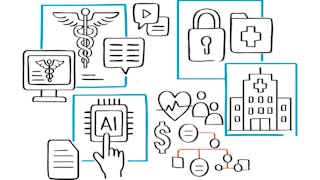Die Verbesserung des Gesundheitswesens und der Gesundheitseinrichtungen erfordert ein Verständnis der Daten und die Entwicklung von Maßnahmen auf den vielen Ebenen, auf denen die Gesundheits-IT interagiert und die Einrichtung beeinflusst. Diese Ebenen reichen von der externen "Welt", in der die Einrichtung arbeitet, bis hin zu den spezifischen Technologien. Wenn Datenwissenschaftler ihre Modelle in die Praxis umsetzen wollen, stellen sie fest, dass es die "sozialen" Komponenten sind, die sowohl neu für sie sind als auch entscheidend für den Erfolg. Am Ende dieses Kurses werden die Teilnehmer in der Lage sein, ein Problem der Gesundheitsinformatik - oder eine vorgeschlagene Lösung - schnell zu beurteilen und festzustellen, was noch fehlt und was noch gelernt werden muss. Für wen ist dieser Kurs geeignet?

Genießen Sie unbegrenztes Wachstum mit einem Jahr Coursera Plus für 199 $ (regulär 399 $). Jetzt sparen.

Der soziale und technische Kontext der Gesundheitsinformatik
Dieser Kurs ist Teil von Spezialisierung für Gesundheitsinformatik

Dozent: Harold P. Lehmann, MD, Ph.D.
46.553 bereits angemeldet
Bei enthalten
(578 Bewertungen)
Empfohlene Erfahrung
Was Sie lernen werden
Formulieren Sie eine kohärente Problemdefinition und einen Plan zur Lösung eines Problems der Gesundheitsinformatik.
Erstellen Sie eine Informatics Stack-Analyse eines Informatikproblems.
Beschreiben Sie elf soziotechnische Aspekte eines Problems oder einer Lösung der Gesundheitsinformatik.
Kompetenzen, die Sie erwerben
- Kategorie: Management von Gesundheitsinformationen und Krankenakten
- Kategorie: Gesundheitspolitik
- Kategorie: Gesundheitspflege
- Kategorie: Aufstrebende Technologien
- Kategorie: Gesundheitstechnologie
- Kategorie: Kenntnisse der Gesundheitsbranche
- Kategorie: Systemanforderungen
- Kategorie: Elektronische Krankenakte
- Kategorie: Datenkompetenz
- Kategorie: Technologie-Strategien
- Kategorie: Gesundheitssysteme
- Kategorie: Management von Gesundheitsinformationen
- Kategorie: Verfahren und Vorschriften im Gesundheitswesen
- Kategorie: Medizinische Bildgebung
- Kategorie: Gesundheitsinformatik
- Kategorie: Informatik
- Kategorie: Interoperabilität
Wichtige Details

Zu Ihrem LinkedIn-Profil hinzufügen
Erfahren Sie, wie Mitarbeiter führender Unternehmen gefragte Kompetenzen erwerben.

Erweitern Sie Ihre Fachkenntnisse
- Lernen Sie neue Konzepte von Branchenexperten
- Gewinnen Sie ein Grundverständnis bestimmter Themen oder Tools
- Erwerben Sie berufsrelevante Kompetenzen durch praktische Projekte
- Erwerben Sie ein Berufszertifikat zur Vorlage

In diesem Kurs gibt es 4 Module
In diesem Modul erhalten Sie eine Einführung in den Kurs und seine grundlegenden Konzepte. Nachdem wir Beispiele für Gesundheits-IT im Kontext von Patienten, Leistungserbringern und Bevölkerungsgruppen - den drei Kontexten, auf die wir immer wieder zurückkommen - vorgestellt haben, erläutern wir die Triebkräfte, die die Entwicklungen in der Gesundheits-IT und -informatik motivieren. Anschließend geben wir die wichtigsten Definitionen von Schlüsselbegriffen (wie "Gesundheits-IT" und "Informatik") und stellen den zentralen Rahmen für Ihre Arbeit in diesem Kurs vor, den Informatics Stack.
Das ist alles enthalten
11 Videos1 Lektüre1 Aufgabe
In diesem Modul beginnen wir unsere Reise entlang des Stacks, um die Welt der Informatik und der Gesundheits-IT zu erklären. Wir erkunden die obersten vier Ebenen des Stacks (Welt, Organisation, Rollen und Funktionen) und erörtern dann die neuen Richtlinien für die medizinische Versorgung in den USA ("Welt"), die die Organisationen des Gesundheitswesens dazu veranlassen, ihre Praxis zu ändern, damit sie ihre Kernfunktionen erfüllen können. Wir erörtern auch die Geschichte der Gesundheits-IT im Zusammenhang mit dieser Politik in der Vergangenheit. Wir beginnen mit einer kursbegleitenden Diskussion über Interoperabilität (die auf jeder Ebene des Stacks stattfindet) und Datenschutz/Vertraulichkeit/Sicherheit. Abschließend erläutern wir die Methoden, mit denen sich bewerten lässt, ob ein IT-Projekt die für dieses Projekt gesetzten organisatorischen Ziele erreicht hat.
Das ist alles enthalten
6 Videos1 Aufgabe
In diesem Modul setzen wir diese Reise fort und beginnen mit der Rolle von Bedürfnissen, Anforderungen und Spezifikationen. Dann wenden wir uns der Frage zu, wie Workflow-Probleme in Anforderungen umgewandelt werden und wie Informationssysteme, die diese Anforderungen erfüllen sollen, zusammengestellt werden. Wir schließen mit der Warnung, dass schlecht entwickelte Systeme genau den Arbeitsabläufen schaden, die sie verbessern sollen.
Das ist alles enthalten
6 Videos1 Aufgabe
Dieses Modul schließt unsere Reise mit Diskussionen über Daten, Informationen, Wissen und Technologie ab. Was die Daten betrifft, so besprechen wir ihre Quellen und Arten und geben Beispiele. Anschließend erklären wir die Unterschiede zwischen Informationen und Daten sowie zwischen Wissen und Informationen. Auf dieser Ebene sind Standards besonders wichtig, und wir besprechen den Austausch von Text- und Bilddaten. Was die Technologie betrifft, so verwenden wir den Hype Cycle, damit Sie den Überblick darüber behalten, welche neuen Technologien was und wann tun. Abschließend geben wir Ihnen einen Rahmen für Ihre Überlegungen zu Karrieren in der Gesundheits-IT und Informatik.
Das ist alles enthalten
11 Videos1 Aufgabe1 peer review
Erwerben Sie ein Karrierezertifikat.
Fügen Sie dieses Zeugnis Ihrem LinkedIn-Profil, Lebenslauf oder CV hinzu. Teilen Sie sie in Social Media und in Ihrer Leistungsbeurteilung.
Dozent

Mehr von Gesundheitsinformatik entdecken
 Status: Vorschau
Status: VorschauNortheastern University
 Status: Vorschau
Status: VorschauNortheastern University

Illinois Tech
 Status: Kostenloser Testzeitraum
Status: Kostenloser TestzeitraumUniversity of California, Davis
Warum entscheiden sich Menschen für Coursera für ihre Karriere?




Bewertungen von Lernenden
578 Bewertungen
- 5 stars
61,31 %
- 4 stars
21,41 %
- 3 stars
8,29 %
- 2 stars
3,28 %
- 1 star
5,69 %
Zeigt 3 von 578 an
Geprüft am 1. Juli 2020
It;s a very interesting course overall. More practical exercises could be more useful instead of tests.
Geprüft am 13. Juni 2020
Content and delivery are very clear and concise, would appreciate some more reading material or reference list for each module but otherwise a wonderful learning resource.
Geprüft am 23. Jan. 2021
I learned a lot about the concept of STACK social and technical application of health informatics.

Neue Karrieremöglichkeiten mit Coursera Plus
Unbegrenzter Zugang zu 10,000+ Weltklasse-Kursen, praktischen Projekten und berufsqualifizierenden Zertifikatsprogrammen - alles in Ihrem Abonnement enthalten
Bringen Sie Ihre Karriere mit einem Online-Abschluss voran.
Erwerben Sie einen Abschluss von erstklassigen Universitäten – 100 % online
Schließen Sie sich mehr als 3.400 Unternehmen in aller Welt an, die sich für Coursera for Business entschieden haben.
Schulen Sie Ihre Mitarbeiter*innen, um sich in der digitalen Wirtschaft zu behaupten.
Häufig gestellte Fragen
Um Zugang zu den Kursmaterialien und Aufgaben zu erhalten und um ein Zertifikat zu erwerben, müssen Sie die Zertifikatserfahrung erwerben, wenn Sie sich für einen Kurs anmelden. Sie können stattdessen eine kostenlose Testversion ausprobieren oder finanzielle Unterstützung beantragen. Der Kurs kann stattdessen die Option "Vollständiger Kurs, kein Zertifikat" anbieten. Mit dieser Option können Sie alle Kursmaterialien einsehen, die erforderlichen Bewertungen abgeben und eine Abschlussnote erhalten. Dies bedeutet auch, dass Sie kein Zertifikat erwerben können.
Wenn Sie sich für den Kurs einschreiben, erhalten Sie Zugang zu allen Kursen der Spezialisierung, und Sie erhalten ein Zertifikat, wenn Sie die Arbeit abgeschlossen haben. Ihr elektronisches Zertifikat wird Ihrer Seite "Leistungen" hinzugefügt - von dort aus können Sie Ihr Zertifikat ausdrucken oder Ihrem LinkedIn-Profil hinzufügen.
Ja. Für ausgewählte Lernprogramme können Sie eine finanzielle Unterstützung oder ein Stipendium beantragen, wenn Sie die Anmeldungsgebühr nicht aufbringen können. Wenn für das von Ihnen gewählte Lernprogramm eine finanzielle Unterstützung oder ein Stipendium verfügbar ist, finden Sie auf der Beschreibungsseite einen Link zur Beantragung.
Weitere Fragen
Finanzielle Unterstützung verfügbar,
¹ Einige Aufgaben in diesem Kurs werden mit AI bewertet. Für diese Aufgaben werden Ihre Daten in Übereinstimmung mit Datenschutzhinweis von Courseraverwendet.

